Tanzania is a country of high risk based on the 2019 INFORM Risk value. Main hazards include floods and droughts. Earthquakes contribute significantly to average socioeconomic losses. The lack of coping capacity is the factor of the highest index value and calls for increased efforts for resilience.
All the activities related to disaster management in the country are coordinated by the Tanzania Disaster Management Department, under the Prime Ministers’ office.
According to the 2015 National Progress Report on the Implementation of Hyogo Framework for Action, there are several development policies, plans and programmes that include disaster risk considerations in Tanzania (Prevention Web, HFA National Progress Reports, 2019). In addition, in the 2017 Report on Sendai Framework Data Readiness Review it is mentioned that there is no national DRR strategy, although recently a draft version is in progress (Prevention Web, HFA National Progress Reports, 2019).
More recently, Tanzania’s Government has reaffirmed its commitment to the Sendai Framework for DRR, stating that it will continue to promote its implementation (UNISDR, 2019). Finally, in the past two years, the government has reportedly been promoting efforts in several sectors, developing Disaster Management Regulations to strengthen coordination mechanism (UNISDR, 2019).
- Prevention Web. (2019, December). HFA National Progress Reports. Retrieved from https://www.preventionweb.net/english/hyogo/progress/reports/
- UNISDR (2019). Global Platform for Disaster Risk Reduction - Speeches and Statements. Retrieved from https://www.unisdr.org/conference/2019/globalplatform/programme/offic…
Tanzania is a big African country which overlooks the Indian Ocean and lies just south of the Equator. Much of the country is covered by a plateau, where a large number of world-famous tourist attractions are found, in particular, the savannah environment with its characteristic flora and fauna, preserved in various parks and nature reserves. This plateau has a subtropical or tropical climate, not too hot because of altitude. On the contrary, the thin coastal stretch is hot and humid throughout the year, especially from November to April.
The June-August period (kipupwe) is the coolest of the year, and is dry almost everywhere.
As regards to the rain pattern, the country can be divided into four zones. In the north and the east, except in the region of Lake Victoria, there are two rainy seasons: one less intense, known as short rains season (vuli), between October and December, and the other more intense, known as long rains season (masika), from March to May, with a peak in April. In January and February, in the period between the two rainy seasons (kiangazi), the weather is hot and sultry, at least below a thousand meters. In the far north-west, the two rainy seasons are practically connected, in fact, it rains even in January and February, when rainfall amounts to 100/150 millimeters per month depending on the area; therefore, in this region, there is practically a single rainy season from October to May. Such a situation is also found in a few areas of the north-east, in particular, along the southern slopes of Mount Kilimanjaro.
In the center and south, there's only one rainy season, from December to April in the south and south-east, and from November to April in the west.

Regional Platform / DRR Contact Point
-
Government of the United Republic of TanzaniaOrganization type:
Risk reduction Policies, Plans & Strategies
Policies, plans and official statements on disaster risk, climate adaptation and resilience.
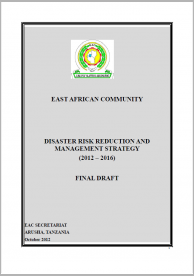
|
East African Community Disaster Risk Reduction and Management Strategy (2012-2016)
The objectives of this Strategy are to provide framework for collaboration and partnership for the EAC Partner States in Disaster Risk Reduction and Management and to facilitate and strengthen the Disaster Risk Reduction and Management activities of the EAC Partner States in line with the Hyogo F |
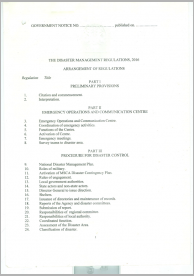
|
Disaster Management Regulations, 2016
Arrangement of Regulations; Makes provisions for Emergency operations and communication centre, procedures for disaster control, disaster management volunteer and related issues. |
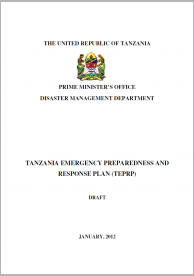
|
Tanzania Emergency Preparedness and Response Plan (TEPRP) - Draft
The TEPRP is a Multi-Hazards functional plan that sets forth appropriate actions to be taken in response to an emergency or major disaster including potential or imminent threat of any event. |
Documents & Publications
Disaster risk reduction and resilience publications, reports, research papers and case studies.
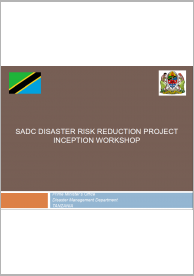
|
Tanzania Presentation - SADC Disaster Risk Reduction Project Inception Workshop
Tanzania presentation in the Strengthening Disaster Risk Reduction, Coordination, Planning and Policy Advisory Capacity of SADC Project Inception Workshop, held in Johannesburg, South Africa, 20-24 January 2020. |

|
District Risk, vulnerability and capacity Assessment Report - Draft
The Risk, Vulnerability and Capacity Assessment (RVCA) for Kilosa district aimed to identify disaster risks, vulnerability and capacities in the district. The findings from the RVCA form the basis for the preparation of the District’s Emergency Preparedness and Response Plan (DEPRP). |

|
Vulnerability Assessment Report 2003
The Disaster Vulnerability Assessment Phase two study is aimed at determining the type, location and frequency of the disasters at national and regional level. To identify the current capacity and coping systems (organizational arrangement) at national and regional level. |
Disaster Data & Statistics
Reports on disaster statistics, country profiles and additional resources on collecting disaster loss data.
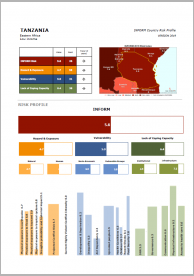
|
INFORM Country Risk Profile - Tanzania
Index for Risk Management. |

